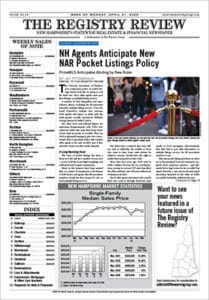
With vacancy rates below 1 percent, real estate developers and investors aren’t batting an eyelash at Amazon’s decision to back down from plans to expand its warehouse footprint by nearly 100 million square feet nation-wide.
Amazon’s decision to bail on plans for a giant logistics center in Hudson comes amid a pullback by the e-commerce giant on warehouse construction that has sent tremors through the industrial property sector nationally.
But while Amazon’s decision certainly didn’t go unnoticed in New Hampshire’s red-hot warehouse sector, neither is it causing too much consternation amid a market where vacancy rates are effectively at zero in the state’s biggest urban centers.
And Amazon’s decision may also highlight another factor that promises to keep demand ahead of supply in the Granite State, even as economic uncertainty grows: a combination of local opposition and state red tape that can delay or even derail new warehouse and distribution projects.
“There is a lack of supply right now,” said Chris Norwood, president of commercial real estate firm NAI Norwood Group, which has developed new warehouse and distribution projects. “There may have been the same demand three years ago, but because there was more supply, you didn’t feel it.”
Major Projects Face Major Opposition
The demise of the online shopping giant’s proposal to build a 2.6 million square feet logistics campus on a golf course in Hudson highlights one major barrier to the industry’s growth in the Granite State, and that is local opposition.
Given its size, Amazon’s plans to build a massive distribution center in Hudson would have surely sparked concern over truck traffic anyway. But plans to pave over 14-acre golf course was a particularly sore point for town residents.
In April, Amazon decided to pull the plug on the project, a decision likely driven as well by bottom line concerns, with the company reporting $2 billion in “incremental costs” as a result of building too much warehouse and distribution space across the country.
Overall, projections for the growth of Amazon’s industrial portfolio have been sharply curtailed, with the company now expected to add 54 million square feet this year, not 84 million, as previously expected, according to The Wall Street Journal.
Also stirring opposition has been a plan in nearby Amherst for a pair of warehouses totaling 1.4 million square feet, with enough parking for 700 tractor-trailers.
The proposal by Kansas-based Flint Development faces opposition from residents of a neighboring condo complex, with Amherst residents having voted, by a 4-1 margin, against rezoning the property in question for industrial use in 2015.
Environmental Rules a Top Obstacle
It’s not just local opposition that is keeping a lid on new warehouse development in New Hampshire, though.
New regulations stemming from a state court case has resulted in major changes in how property owners and developers comply with the endangered species laws.
Previously, the onus was state or local officials to determine whether a tract of forest or other undeveloped lot also happened to be home to animals on the federal government’s endangered species list, according to Norwood.
But a recent state court decision flipped the script, putting he onus on developers to prove there are no endangered species on their proposed construction sites. There are currently more than two dozen animals on the list for New Hampshire, including the timber rattlesnake, the marbled salamander, and the eastern small-footed bat.
While the expense is not a huge issue, it can be a time-consuming, months-long process to comply with the new rules, Norwood said.
That’s in addition to dealing with regulations dealing with wetlands and other environmental issues.
During the pandemic, the permit approval process on some warehouse projects slowed considerably, Suddenly, proposals were taking nine, 12 or even 18 months move through the regulatory pipeline, the result of the new endangered species rules and staff shortages on the regulatory side as well. That’s compared to about six months in pre-covid times, Norwood said.
The lag times have seen leveled off, but it’s not clear whether that will last as federal pandemic aid that local communities have relied on to hire staff begins to run out, Norwood said.
“It’s not as much as the cost,” Norwood said. “It’s more about the time lag.”
A Tight Market Anyway You Cut It
The delays in permitting, combined with the upsurge in demand for warehouse space during the pandemic, has resulted in a New Hampshire industrial market with few options for companies seeking distribution and warehouse space.
The state’s two largest industrial space markets, Manchester and Portsmouth, have vacancy rates of 0.2 and 0.9 percent respectively, while the rate for the Granite State as a whole fell to 2.9 percent in the first quarter, according to Kristie Russell, research manager at Colliers’ Manchester office.
That’s down from 4.8 percent before the pandemic.
“The warehouse category in New Hampshire has always been right, but since the pandemic, there has been a steep decrease in the vacancy rate till where it’s practically zero in the Portsmouth and Manchester submarkets,” Russell said.
Rents have also jumped, with developers and owners of new warehouse space now emboldened to ask for $10 or more a square foot, up from $5 to $6.60 a square foot a few years ago.
“Rents are stupid,” Norwood said. “Now with a straight face you can ask for $10 [per square foot] net. I am not saying everyone is paying it but no one is laughing them out of the room.”
And at least for now, developers in New Hampshire are paying closer attention to those vacancy and rent figures, rather than Amazon’s pullback in Hudson and elsewhere, as they forge ahead with a number of new projects.
“There is a lot of construction that is already underway,” Russell said. “We have almost half a million square feet proposed or starting construction in the warehouse category alone.”

